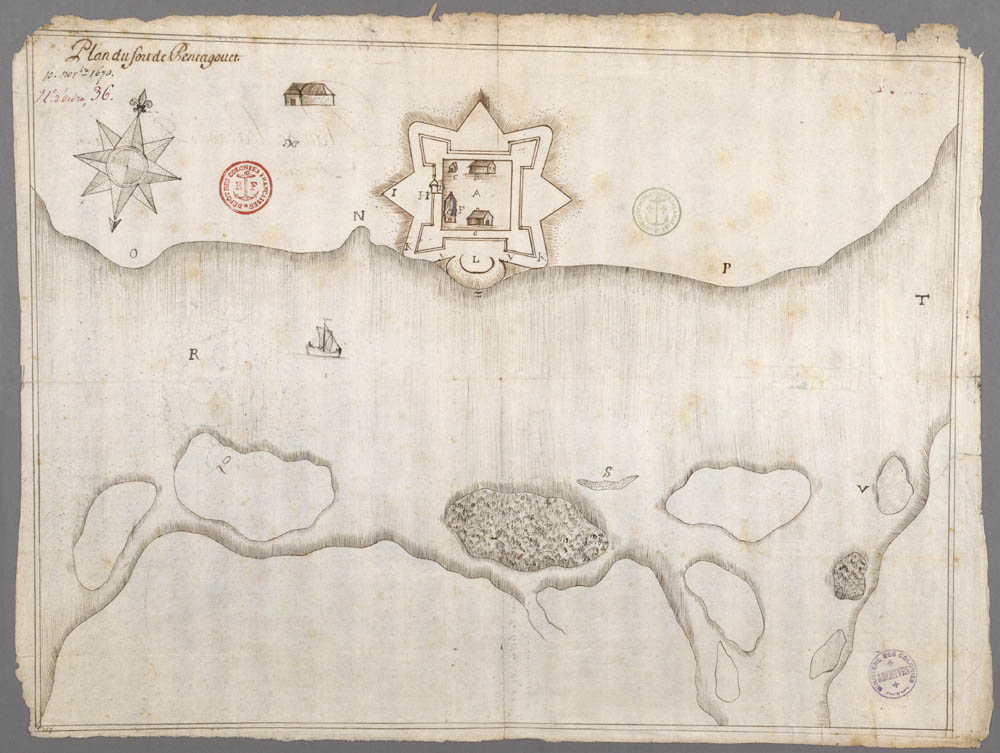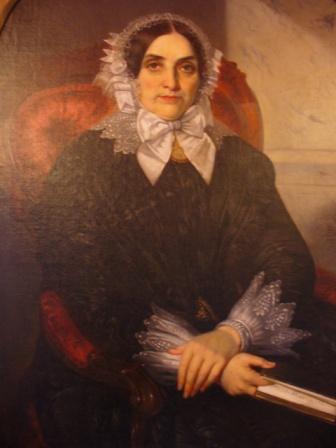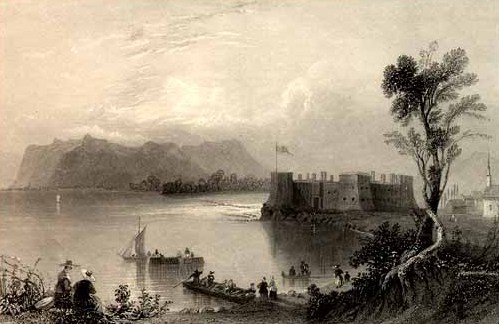|
Jacques De Chambly
Jacques de Chambly (died 1687) was from a French military background and became a seigneur in the New World and a governor of Acadia. Chambly arrived in New France in 1665 when he was a captain in the Carignan-Salières Regiment. He immediately was in charge of the construction of Fort Saint-Louis (now known as Fort Chambly) on the Richelieu Rapids. He then took part in the Prouville de Tracy’s expedition against the Iroquois. When his regiment was disbanded he returned to France but returned to service in Canada in 1670. In 1672 he received a seigneury on the Richelieu River in present-day Quebec, Canada. In 1673 he was appointed governor of Acadia, replacing Hector d'Andigné de Grandfontaine at the capital of Acadia, Fort Pentagouet Fort Pentagouët (Fort Pentagoet, Fort Castine, Fort Penobscot, Fort Saint-Pierre) was a French fort established in present-day Castine, Maine, which was the capital of Acadia (1670–1674). It is the oldest permanent settlement in New Engl ... [...More Info...] [...Related Items...] OR: [Wikipedia] [Google] [Baidu] |
List Of Governors Of Acadia
The governance of the French colony of Acadia has a long and tangled history. Founded in 1603 by Pierre Dugua, Sieur de Monts, the territory of Acadia (roughly, the present-day Canadian provinces of Nova Scotia, New Brunswick, and Prince Edward Island, and portions of the U. S. state of Maine) was hotly contested in the 17th century. It was claimed by English and Scottish interests, fought over by competing French governors, and subjected to raids and attacks from English colonists that sometimes resulted in years of occupation of some of its communities. Most of the non-French claims were given up under the 1667 Treaty of Breda, but the territory did not come completely under French control until three years later. From 1670 until 1710 the province remained in French hands, except for a brief period in the 1670s when Dutch attackers occupied several Acadian communities. In 1710 a British expedition including Royal Navy warships and colonial forces from New England captured ... [...More Info...] [...Related Items...] OR: [Wikipedia] [Google] [Baidu] |
New France
New France (french: Nouvelle-France) was the area colonized by France in North America, beginning with the exploration of the Gulf of Saint Lawrence by Jacques Cartier in 1534 and ending with the cession of New France to Great Britain and Spain in 1763 under the Treaty of Paris. The vast territory of ''New France'' consisted of five colonies at its peak in 1712, each with its own administration: Canada, the most developed colony, was divided into the districts of Québec, Trois-Rivières, and Montréal; Hudson Bay; Acadie in the northeast; Plaisance on the island of Newfoundland; and Louisiane. It extended from Newfoundland to the Canadian Prairies and from Hudson Bay to the Gulf of Mexico, including all the Great Lakes of North America. In the 16th century, the lands were used primarily to draw from the wealth of natural resources such as furs through trade with the various indigenous peoples. In the seventeenth century, successful settlements began in Acadia and in Quebe ... [...More Info...] [...Related Items...] OR: [Wikipedia] [Google] [Baidu] |
1687 Deaths
Events January–March * January 3 – With the end of latest of the Savoyard–Waldensian wars in the Duchy of Savoy between the Savoyard government and Protestant Italians known as the Waldensians, Victor Amadeus III, Duke of Savoy, carries out the release of 3,847 surviving prisoners and their families, who had forcibly been converted to Catholicism, and permits the group to emigrate to Switzerland. * January 8 – Richard Talbot, 1st Earl of Tyrconnell, is appointed as the last Lord Deputy of Ireland by the English crown, and begins efforts to include more Roman Catholic Irishmen in the administration. Upon the removal of King James II in England and Scotland, the Earl of Tyrconnell loses his job and is replaced by James, who reigns briefly as King of Ireland until William III establishes his rule over the isle. * January 27 – In one of the most sensational cases in England in the 17th century, midwife Mary Hobry murders her abusive husband, Denis H ... [...More Info...] [...Related Items...] OR: [Wikipedia] [Google] [Baidu] |
Year Of Birth Missing
A year or annus is the orbital period of a planetary body, for example, the Earth, moving in its orbit around the Sun. Due to the Earth's axial tilt, the course of a year sees the passing of the seasons, marked by change in weather, the hours of daylight, and, consequently, vegetation and soil fertility. In temperate and subpolar regions around the planet, four seasons are generally recognized: spring, summer, autumn and winter. In tropical and subtropical regions, several geographical sectors do not present defined seasons; but in the seasonal tropics, the annual wet and dry seasons are recognized and tracked. A calendar year is an approximation of the number of days of the Earth's orbital period, as counted in a given calendar. The Gregorian calendar, or modern calendar, presents its calendar year to be either a common year of 365 days or a leap year of 366 days, as do the Julian calendars. For the Gregorian calendar, the average length of the calendar year (the mea ... [...More Info...] [...Related Items...] OR: [Wikipedia] [Google] [Baidu] |
Fort Pentagouet
Fort Pentagouët (Fort Pentagoet, Fort Castine, Fort Penobscot, Fort Saint-Pierre) was a French fort established in present-day Castine, Maine, which was the capital of Acadia (1670–1674). It is the oldest permanent settlement in New England. Its commanding position at the mouth of the Penobscot River estuary, a lucrative source of furs and timber, as well as a major transportation route into the interior, made the peninsula of particular interest to European powers in the 17th century. Majabagaduce (as the Abenaki name would be corrupted) changed hands numerous times with shifting imperial politics. At one time or another, it was occupied by the French, Dutch and England's Plymouth Colony. La Tour Castine was founded in the winter of 1613, when Claude de Saint-Étienne de la Tour established a small trading post to conduct business with the Tarrantine Indians (now called the Penobscots). After the trading post was established at Castine, a raid by English captain Samuel Arg ... [...More Info...] [...Related Items...] OR: [Wikipedia] [Google] [Baidu] |
Quebec
Quebec ( ; )According to the Canadian government, ''Québec'' (with the acute accent) is the official name in Canadian French and ''Quebec'' (without the accent) is the province's official name in Canadian English is one of the thirteen provinces and territories of Canada. It is the largest province by area and the second-largest by population. Much of the population lives in urban areas along the St. Lawrence River, between the most populous city, Montreal, and the provincial capital, Quebec City. Quebec is the home of the Québécois nation. Located in Central Canada, the province shares land borders with Ontario to the west, Newfoundland and Labrador to the northeast, New Brunswick to the southeast, and a coastal border with Nunavut; in the south it borders Maine, New Hampshire, Vermont, and New York in the United States. Between 1534 and 1763, Quebec was called ''Canada'' and was the most developed colony in New France. Following the Seven Years' War, Quebec b ... [...More Info...] [...Related Items...] OR: [Wikipedia] [Google] [Baidu] |
Richelieu River
The Richelieu River () is a river of Quebec, Canada, and a major right-bank tributary of the St. Lawrence River. It rises at Lake Champlain, from which it flows northward through Quebec and empties into the St. Lawrence. It was formerly known by the French as the Iroquois River and the Chambly River, and was named for Cardinal Richelieu, the powerful minister under Louis XIII. This river was a long a key route of water transport for trading, first by indigenous peoples, and then for cross-border trade between Canada and the United States. With 19th-century construction of the Champlain Canal (1823) south of the Lake Champlain and the Chambly Canal (1843) to the north, the Richelieu provided a direct route from the Saint Lawrence River to New York via Lake Champlain, the canals, and the Hudson River. The construction of rail transport in the mid-19th century competed with such river/canal routes and ultimately succeeded them, because of faster service with greater freight c ... [...More Info...] [...Related Items...] OR: [Wikipedia] [Google] [Baidu] |
Seigneury
''Seigneur'' is an originally feudal title in France before the Revolution, in New France and British North America until 1854, and in the Channel Islands to this day. A seigneur refers to the person or collective who owned a ''seigneurie'' (or ''seigneury'')—a form of land tenure—as a fief, with its associated rights over person and property. A seigneur could be an individual—male or female (''seigneuresse''), noble or non-noble (''roturier'')—or a collective entity such a religious community, monastery, seminary, college, or parish. This form of lordship was called ''seigneurie'', the rights that the seigneur was entitled to were called ''seigneuriage'', and the jurisdiction exercised was ''seigneur justicier'' over his fief. In the wake of the French Revolution, seigneurialism was repealed in France on 4 August 1789 and in the Province of Canada on 18 December 1854. Since then, the feudal title has only been applicable in the Channel Islands and for sovereign princ ... [...More Info...] [...Related Items...] OR: [Wikipedia] [Google] [Baidu] |
Alexandre De Prouville Tracy
Marquis Alexandre de Prouville de Tracy (c. 1596 or 1603 – 1670) was a French aristocrat, statesman, and military leader. He was the seigneur of Tracy-le-Val and Tracy-le-Mont (Picardy). Life The Marquis de Tracy first made his name as a regimental commander in Germany in the 1640s, then was appointed Commissary-General of the French troops serving in Germany. In 1647 he represented France at the Ulm negotiations with Sweden and Bavaria. In 1664 a fleet under the Marquis de Tracy carried a force of soldiers and colonists led by Antoine Lefèbvre de La Barre of the newly formed Compagnie de la France équinoxiale to Cayenne. They left the port of La Rochelle, France, on 26 February 1664 with two warships and 400 soldiers. The expedition included 1,200 settlers. They arrived in Cayenne on 11 May 1664. On 15 May 1664 the Dutch general Guerin Spranger agreed to capitulate. The Marquis de Tracy was then appointed lieutenant-général of New France. The governor was not present, s ... [...More Info...] [...Related Items...] OR: [Wikipedia] [Google] [Baidu] |
Fort Chambly
Fort Chambly is a historic fort in La Vallée-du-Richelieu Regional County Municipality, Quebec. It is designated as a National Historic Site of Canada. Fort Chambly was formerly known as Fort St. Louis. It was part of a series of five fortifications built along the Richelieu River to protect travellers on the river from the Iroquois. The region is informally known as la Vallée-des-Forts. History Fort Chambly at the foot of the Chambly rapids on the Richelieu River in Quebec, Canada, was built by the French in 1711. It was the last of three forts to be built on the same site. The first — then called Fort Saint Louis — was constructed in 1665 by captain Jacques de Chambly, to protect New France from Iroquois attacks. After minor repairs, the fort was burned by the Indians in 1702, but was reconstructed the same year. By then it was already known as Fort Chambly. However, with the Great Peace of Montreal in 1701, the war between the French and Iroquois was over. ... [...More Info...] [...Related Items...] OR: [Wikipedia] [Google] [Baidu] |
Carignan-Salières Regiment
The Carignan-Salières Regiment was a Piedmont French military unit formed by merging two other regiments in 1659. They were led by the new Governor, Daniel de Rémy de Courcelles, and Lieutenant-General Alexandre de Prouville, Sieur de Tracy. Approximately 1,200 men (Piedmont, Savoyard and Ligurian) arrived in New France in the middle of 1665. Formation The Carignan-Salières was formed from two existing regiments: the Balthasar Regiment, formed during the Thirty Years' War and becoming the Salières when Balthasar died in 1665, and the Carignan Regiment, formed in 1644 in Piedmont. Following the Treaty of the Pyrenees in 1659, both regiments avoided disbandment by merging to form the Carignan-Salières Regiment. Crisis In New France New France was initially a proprietary colony granted by the French Crown to various corporations to rule provided they fulfilled various terms of their charters like supporting the missionary work of the Roman Catholic Church amongst the Autochto ... [...More Info...] [...Related Items...] OR: [Wikipedia] [Google] [Baidu] |
Acadia
Acadia (french: link=no, Acadie) was a colony of New France in northeastern North America which included parts of what are now the Maritime provinces, the Gaspé Peninsula and Maine to the Kennebec River. During much of the 17th and early 18th centuries, Norridgewock on the Kennebec River and Castine at the end of the Penobscot River were the southernmost settlements of Acadia. The French government specified land bordering the Atlantic coast, roughly between the 40th and 46th parallels. It was eventually divided into British colonies. The population of Acadia included the various indigenous First Nations that comprised the Wabanaki Confederacy, the Acadian people and other French settlers. The first capital of Acadia was established in 1605 as Port-Royal. An English force from Virginia attacked and burned down the town in 1613, but it was later rebuilt nearby, where it remained the longest-serving capital of French Acadia until the British siege of Port Royal in 17 ... [...More Info...] [...Related Items...] OR: [Wikipedia] [Google] [Baidu] |







